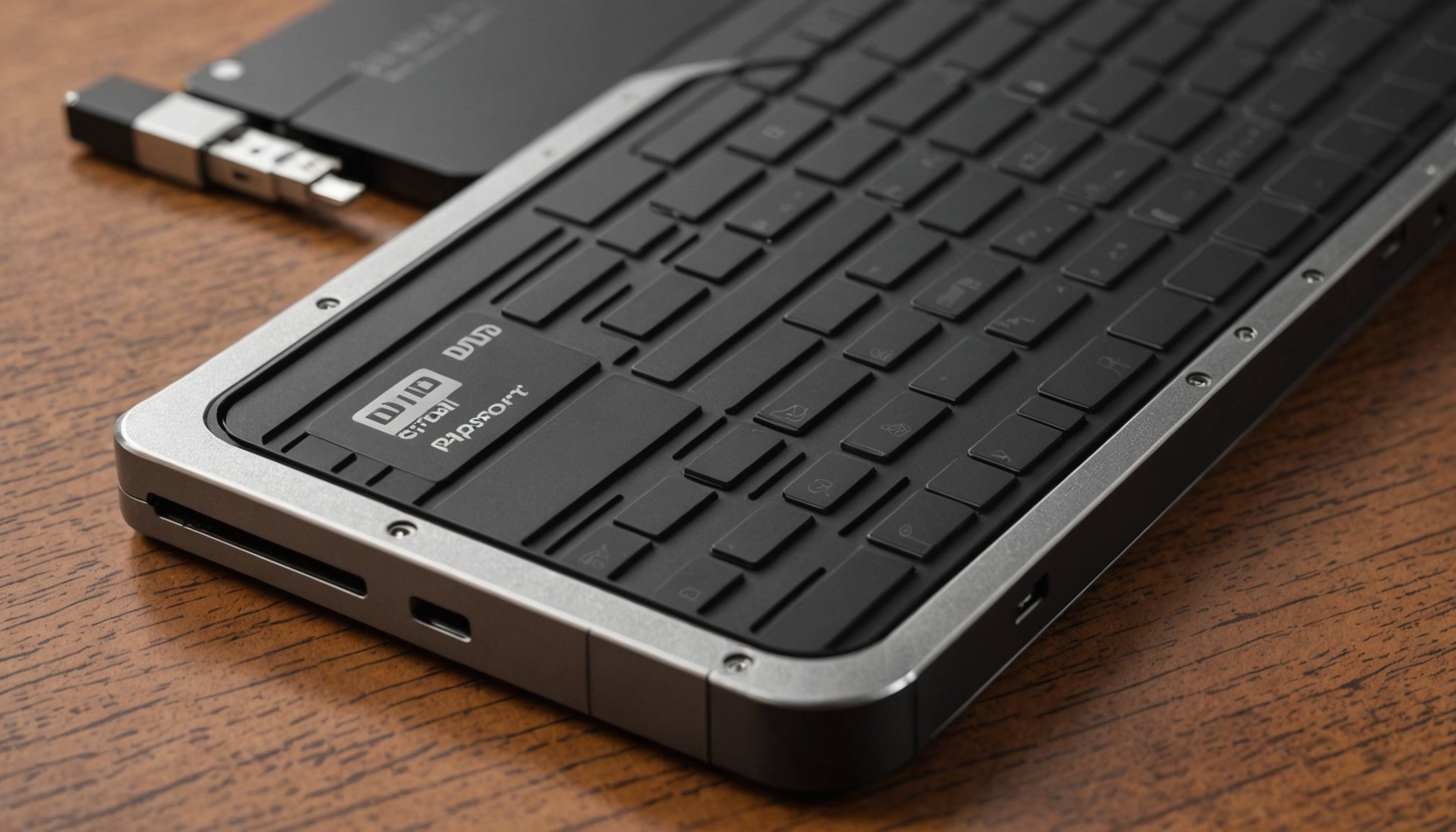Importance of Data Security During File Transfers
In the digital age, ensuring data security during file transfers is crucial. One of the most prevalent risks associated with unsecured file transfers includes unauthorized access to sensitive information. Hackers can intercept data, leading to potential breaches. The consequences of such breaches are severe, often resulting in loss of personal data, financial damage, and reputational harm to individuals and businesses.
The Western Digital My Passport SSD offers a robust solution to these challenges, providing encrypted data protection. By choosing the right storage solution, you mitigate the risks associated with unsecured file transfers. Encrypted storage devices like the Western Digital My Passport SSD ensure that your files remain safe, even if they fall into the wrong hands.
Also to discover : Unlocking the power of proxmox ve: a comprehensive guide to building a high-performance virtualization server on your amd ryzen 9 5900x
Data breaches do not only result in loss of information but also pose legal implications, especially with stringent regulations like GDPR. This makes securing your file transfers a top priority. It’s vital to choose a reliable, secure storage solution that protects sensitive information during transit.
Selecting the right tools, like the Western Digital My Passport SSD, not only safeguards against unauthorized access but also offers peace of mind, knowing your data security is maintained throughout the process. Prioritize secure file transfer solutions to effectively combat the growing threat of cybercrime.
Also to discover : Unlock extended battery performance: pro strategies for tuning power settings on your hp zbook firefly 15 g7
Best Practices for Enhancing Data Security
In an era where safeguarding information is paramount, understanding and implementing best practices for data security is essential. A critical component of this is employing robust password protection for all your devices. Strong passwords act as a formidable barrier against unauthorized access, ensuring that sensitive data remains confidential. Opt for a combination of uppercase and lowercase letters, numbers, and special characters to fortify your defences.
Another vital strategy involves regularly updating firmware and software. Outdated software can be a vulnerability, providing an entry point for malicious attacks. By routinely updating your systems, you enhance the security framework, close potential loopholes, and prevent data breaches effectively.
A frequently overlooked but equally significant aspect of data security is the physical protection of your SSD. Secure transfers and handling can avoid the risk of physical damage or theft. Physical locks, safes, or secure storage solutions provide an extra layer of security, ensuring the integrity of your device.
Finally, ensure secure transfers of data by using encrypted connections. By focusing on these data protection strategies, your information remains protected from both digital threats and physical compromises. Remember, a proactive approach today can save you from potential data loss tomorrow.
Encryption Methods for Secure File Transfers
In today’s digital age, data encryption is crucial for maintaining privacy and safeguarding sensitive information during secure file transfers. Encryption transforms data into a coded format, ensuring that only authorized parties can access it.
Types of Encryption
AES (Advanced Encryption Standard) and RSA (Rivest-Shamir-Adleman) are two common encryption standards employed for securing files. AES falls under symmetric encryption, meaning it uses a single key for both encryption and decryption. This method is known for its speed and efficiency, making it ideal for encrypting large volumes of data.
Conversely, RSA is an example of asymmetric encryption, which uses a pair of keys: one public and one private. This adds a layer of security since the decryption key remains confidential, offering stronger protection in scenarios where data is shared externally.
How to Enable Encryption on My Passport SSD
Setting up encryption on a My Passport SSD is straightforward. Start by installing the included software, WD Security. Once installed, launch the software and follow the on-screen instructions to create a password. Ensure this password is strong and unique for optimum data protection. Several third-party tools, like VeraCrypt or BitLocker, can further aid in securing data with advanced encryption features.
Advantages of Using Encryption
Employing encryption ensures both data integrity and confidentiality, preventing unauthorized access or alterations. In practice, countless organizations have evaded data breaches thanks to robust encryption strategies, underlining its effectiveness in protecting sensitive information.
Secure File Transfer Protocols
Understanding file transfer protocols is crucial for safeguarding your data during online exchanges. When selecting secure transfer methods, you might consider SFTP, FTPS, and HTTPS. Each offers unique benefits for enhancing FTP security.
Common Secure Protocols
- SFTP (Secure File Transfer Protocol) integrates both file access and transfer over a single reliable connection using SSH. It encrypts commands and data, effectively preventing eavesdropping and data breaches.
- FTPS (FTP Secure) is an extension of FTP that adds SSL or TLS for encryption. It secures the connection but can be more complex due to the requirement of more ports for communication.
- HTTPS (Hypertext Transfer Protocol Secure) is widely used for secure web-based applications. While it mainly secures data in transit for web pages, it can also be used for file transfers.
Setting Up Secure Transfer Protocols
When using secure protocols with the My Passport SSD, follow these steps:
- Use SFTP or FTPS within your file transfer software settings.
- Configure the application to enforce strong encryption protocols.
- Regularly update the software to patch any security vulnerabilities.
Real-World Applications and Examples
Many organizations implement secure protocols to protect sensitive data. One case study highlights how a financial institution avoided data leaks by adopting SFTP. Be aware of potential pitfalls, such as misconfigured security settings, and ensure regular audits to uphold data integrity.
Regular Backup Strategies
Navigating the world of data backup can often feel overwhelming, yet it’s an essential practice for ensuring your files’ safety. Backups, done routinely, are a critical line of defense against data loss, allowing for seamless file recovery in case of device failure or corruption. Setting a backup strategy starts with choosing the right tools and software. For those who use the My Passport SSD, several solutions are tailored to meet varied needs.
Backup tools such as Acronis True Image or EaseUS Todo Backup can offer comprehensive coverage, ensuring that your data is backed up efficiently. Both provide easy-to-use interfaces while supporting full system backups, which is crucial for total file recovery. Your backup strategy should also include establishing a schedule. Regular, incremental backups—daily or weekly—can mitigate the risk of significant data loss, balancing thoroughness with practicality.
Storing backups is another pivotal aspect. While keeping them on your physical My Passport SSD is a good start, maintaining an offsite backup is advisable. Cloud solutions like Dropbox or Google Drive offer security by ensuring your backup isn’t susceptible to physical damage. Remember, a well-thought-out data backup strategy can serve as a safeguard, giving you peace of mind and protecting your digital assets.
Recommended Software Tools for Data Security
In the ever-evolving landscape of digital security, selecting the right security software is vital to protect sensitive your information. When managing files and safeguarding data, having dependable data security tools can significantly diminish risks.
Top Tools for Encryption and Secure Transfers
For encryption and secure file transfers, several key applications stand out. Evaluating both their features and pricing is essential. Notable examples include:
- BitLocker: A robust encryption service integrated into Windows, offering essential security for sensitive data. Pricing is included within certain Windows editions, thus providing a cost-effective solution.
- VeraCrypt: This open-source software provides advanced encryption, highly valued for its security strength and customisation options. It is free, making it an attractive choice for many.
- Boxcryptor: Aimed at enhancing cloud storage security, it supports multiple platforms. It offers both free and paid versions, catering to diverse user needs.
It’s critical to consider the balance of features against cost when selecting among these tools. Each tool’s capability to deliver encryption and secure transfers elevates its status as a trusted file management solution. Evaluating factors like ease of integration into existing systems and specific security needs will further guide effective decision-making.
Common Pitfalls to Avoid
In the realm of data transfer pitfalls, awareness is key to safeguarding your digital environment. Many users often stumble at the regular need for updates and patches, a critical area where neglect can lead to serious security mistakes. Keeping software updated ensures that vulnerabilities are patched and systems remain resilient against new threats. This avoids a lapse in security which could lead to data breaches or other cyber threats.
One of the most frequent mistakes made is underestimating the importance of staying informed about evolving threats. Cybersecurity is an ever-changing field, with new vulnerabilities appearing regularly. It’s crucial for users to subscribe to reliable cybersecurity news sources and alerts to remain on top of potential threats.
For those keen on avoidance strategies, it is beneficial to conduct regular security audits and risk assessments. This involves identifying potential vulnerabilities within your system and addressing them proactively. Emphasizing regular training on security best practices can also mitigate user errors effectively.
Furthermore, implementing multi-factor authentication and using robust encryption methods are excellent strategies for enhancing security. These measures act as significant deterrents against unauthorized access. By emphasizing informed actions and regular maintenance, the risk of data transfer pitfalls can be dramatically reduced.
Conclusion and Resources
In today’s digital age, understanding data security is more important than ever. It’s essential to keep abreast with updated information and expert advice. Additional resources are invaluable in learning more about these topics. For those looking to deepen their understanding, numerous reputable books, articles, and websites are available. This section aims to equip you with a wealth of information to further your knowledge.
Additional Resources
To solidify your grasp on data security, consider the following:
- Books: Look for titles from leading security experts that provide comprehensive insights into data protection best practices.
- Articles: Recorate domains that routinely publish authoritative content on emerging threats and security solutions.
- Websites: Certain online platforms offer courses that delve into both the theory and practical aspects of information security.
Recommended Readings and References
It’s also crucial to continually educate oneself in an ever-evolving field. A commitment to ongoing learning ensures you remain informed about the latest best practices and technological advancements. Consider exploring well-regarded publications like the Journal of Cybersecurity or SecurityFocus for in-depth analyses and case studies. Investing time in these additional resources will enhance your ability to safeguard digital environments effectively.











